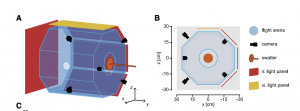Flying insects, such as mosquitoes, have evolved the ability to evade looming objects such as predators and swatting hands. This is a useful skill since the intended blood hosts of mosquitoes often exhibit defense behaviors, like swatting or tail swishing, in order to kill them. It has been observed through previous research that mosquitoes rely on evasive maneuvers and erratic flight behaviors to escape looming threats produced by defensive blood hosts. To detect these threats mosquitoes use visual cues and mechanoreceptors (antennas and sensory hairs). However, not all mosquitoes are able to rely on visual stimuli to predict on-coming attacks; night-active mosquitoes, who feed in darkness, must rely on their mechanoreceptors to detect air movement generated by the attacker. For this reason, the study tested how attacked mosquitoes rely on unpredictable flight paths, changes in flight speeds, and escape maneuverability to maximize their escape performance. More specifically, the study focused on comparing these escape techniques of day-active and night-active mosquitoes in various natural light conditions in order to gain insight into how different light conditions influence their escape performance. It was hypothesized that day-active mosquitoes would rely principally on vision to detect a threat and would struggle if light conditions were less than optimal. Night-active mosquitos were hypothesized to rely principally on any air gusts generated by the attacker and it was predicted that their escape performance would not be influenced by the varied light conditions.
Through the experiment, the researchers attempted to replicate a typical attack situation within a lab. This was accomplished by placing a mosquito inside a flight arena with a real-time videography-based mosquito tracking system to record their 3D movement. Additionally, the flight arena also had a mechanical swatter built in to stimulate the attack of a human hand (generating both visual and air movement cues). The mechanical swatter was triggered based on the prediction that the mosquito would fly into a sphere in the middle of the arena. Through 54 experimental trials, they recorded and analyzed 13,730 mosquito flight tracks.
The results showed that the mosquitoes’ escape performance generally improved when the natural light condition in the arena matched their usual environment in nature. Thus, night-active mosquitoes were significantly less likely to be hit by the swatter if they were flying in their reference (dark) conditions. This trend is comparable for the day-active mosquitoes as well. They were hit by the swatter less frequently in their reference (overcast daylight) condition. However, unlike the night-active mosquitoes, the results were not significant. These results for the night-active mosquitoes are particularly interesting because they exemplify that it is not necessarily advantageous for an organism to suddenly gain a sensory modality they are not used to using. In this case, the sudden ability to use visual stimuli actually hindered the night-active mosquitoes from improving their escape performance. They escaped more effectively without visual cues and this is likely because they operate without such cues in their natural environment. These results differ from the hypothesized outcome which predicted that day-active mosquitoes would be more influenced by the varied light conditions when compared to the night-active mosquitoes.
Additionally, the study characterized the mosquitoes’ flight speed patterns within varied light conditions while the swatter attacked them. It was observed that overall, night-active mosquitoes flew faster in their reference condition (dark) than in the altered condition (overcast daylight). Similarly, day-active mosquitoes were observed to have higher flight speeds in their reference light conditions (overcast daylight) however the difference was not significant. This portion of results corresponds with the previously explained results: that the mosquitoes operate more effectively when tested in light conditions which match their normal environment. Likewise, this fits the hypothesis which predicted that the mosquitoes will operate best when they are in their reference light environment.
A commonality in the results is that both day-active and night-active mosquitoes strategically deviated from their predicted flight path by making sudden turns or changing their flight speed regardless of light conditions. Both species deviated from their predicted flight path equally as frequently when anticipating a swatter attack. To contextualize, predators and hosts of mosquitoes have often been found to wait for optimal conditions before eliciting an attack so this erratic flight behavior potentially reduces the chances of attack initialization and attack success. It is fitting that both day-active and night-active species would excel at this behavior even though they often operate in different natural light conditions. This study reinforced the concept that mosquitoes will use escape maneuvers and unpredictable flight paths when faced with a threat; this behavior is crucial for them to evade looming objects regardless of light conditions in the environment.
This study gave great insight into how natural light conditions affect day-active and night-active mosquitoes’ ability to escape looming objects, however, the simplified kinematics of the mechanical swatter is a point of limitation within this study. Although the prediction method for how they programmed the swatter is similar to how humans or dragonflies have been found to attack mosquitoes, these living organisms are more sophisticated prediction models since they are continuously updating their predictions. With continuous advancements in technology, these mechanical models will undoubtedly improve and become more accurate.
In the future, more comparative studies could be performed between additional species of day-active and night-active mosquitoes. This study consisted of a two-species comparative analysis which is too small to be used to directly prove evolutionary adaptations.
Cribellier et al., Diurnal and nocturnal mosquitoes escape looming threats using distinct flight strategies, Current Biology (2022). https://doi.org/10.1016/j.cub.2022.01.036

A schematic view of the flight arena with the camera tracking system and the event triggered mechanical swatter.
